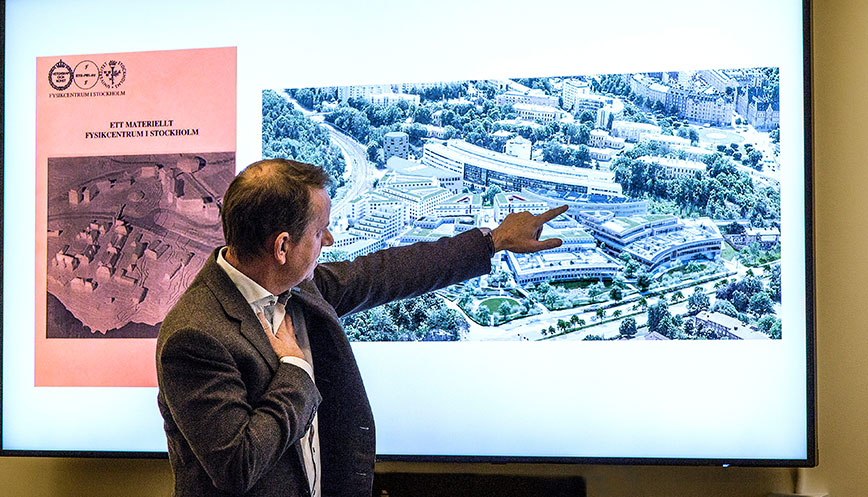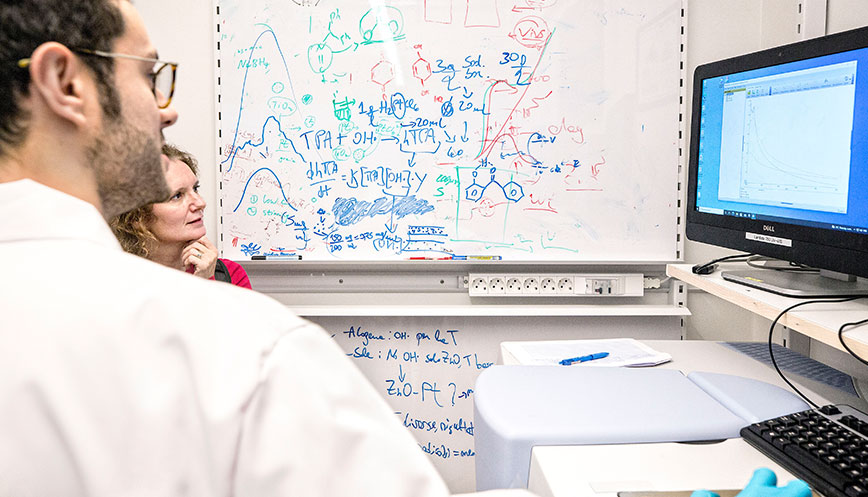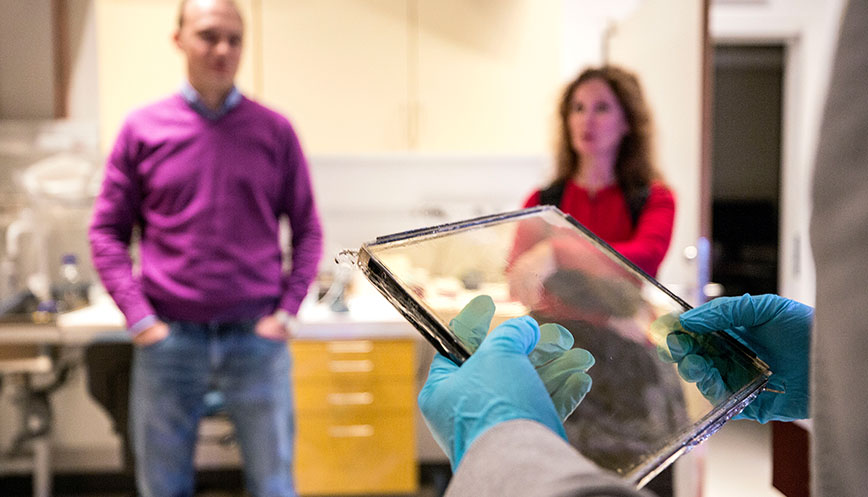KTH Energy Platform learns about advances in research during a visit to the SCI-school´s new “Nova”

During the autumn, the KTH Energy Platform visited several of the departments at the School of Engineering Sciences (SCI) in their new Nova building on Campus Albanova, where participants learnt about breakthroughs in hydrogen production and window glass with nanoparticles that capture solar energy.
At the SCI school, the Energy Platform was received by Joydeep Dutta, professor of functional materials; Saulius Marcinkevicius, professor of optics; Ilja Sytjugov, professor of applied physics; and Oscar Tjernberg, professor of highly correlated systems and students and doctoral students demonstrated labs and ongoing experiments. As well as a number of students and doctoral students who showed labs and ongoing experiments.
Lina Bertling Tjernberg, director of KTH Energy Platform; Christophe Duwig, deputy director and Pierre Bodin, research advisor for strategic initiatives with a focus on energy, represented KTH Energy Platform.
New Campus Albanova
During the visit, Oscar Tjernberg provided details about why the School of Engineering Science’s Department of Applied Physics moved recently to Campus AlbaNova. Today, most research groups gather here to improve collaboration. The Energy Platform visiting some of those who were previously based in Kista in 2019 .

Nova is the first building of the new campus at Hannes Alvéns väg 12, which is also currently home to the Department of Applied Physics. The move took place in the spring of 2020. KTH has two of the floors in the building where Nordita, the Nordic Institute for Theoretical Physics, is also housed.
Campus Albano is planned to accommodate approximately 150,000 square meters of university and college premises, of which approximately 50,000 square meters are earmarked for student and research housing. The goal is to create an attractive educational and research environment that forms a hub between KTH, Stockholm University and Karolinska Institutet.
Sustainable materials for the energy sector
The visit began with Professor Joydeep Dutta describing how the Materials and Nanophysics Group works on the interaction between light and materials to develop sustainable materials for the energy sector. Basic and applied research is conducted here in functional materials, materials theory, quantum materials, spin electronics, durable materials, surface physics and ultra-fast electron microscopy.

In the field of functional materials, new materials are developed for applications in areas such as the environment, energy and food. Understanding of materials is being broadened, for example in catalysts for reducing carbon dioxide emissions, which is done in collaboration with Lund University. New materials are also being developed for solar cells and energy storage. Ultra-fast electron microscopy is improving understanding of each new material. Some research activity is also conducted at the MAX IV laboratory in Lund.
Among the research projects conducted at the department are projects supported by the Energy Platform looking into the use of solar energy as a heat source with the help of a special surface coating.
New methods are also being developed to capture carbon dioxide and convert it into new fuels with the help of new types of catalysors.
Hydrogen production breakthrough
The biggest news of the visit was also delivered by Joydeep Dutta when revealed details about the progress that has been made recently in splitting water molecules to produce hydrogen. Something that has long been considered a “holy grail” in the energy field, he said.
With the help of new functional materials, the research group has recorded results that will now be patented and published. The research has already attracted interest among several companies and the idea is to further develop findings either in-house or in collaboration with industry.
Saulius Marcinkevicius, professor of optics, then spoke about the Department of Photonics where almost all research is energy-related. Fundamental research is conducted here into new energy materials, communication, nanostructures for solar cells and LED lighting. The research is funded by sources such as the Swedish Energy Agency, the Swedish Research Council and the EU.
Marcinkevicius spoke about several research projects, including one focusing on the development of new forms of LED lights that incorporate a broader spectrum of colors. The goal of the project is to find a solution that is more energy efficient than today. Some of the research in this project is conducted at UC Santa Barbara in the US. The department also conducts projects into developing new solar cell materials with the help of gallium indium phosphide, which can expand the light spectrum capable of extracting energy.
Research in nanoparticles may also lead to new solutions to increase the power of LED lamps and new metamaterials that reduce the energy consumption of sensors. The department also develops new materials for passive cooling.
Finally, details were also provided about research with the aim of increasing the speed of today’s data communications, an area where labs around the world are competing.

Producing hydrogen with solar energy
A tour was then made of the Nova labs. In the first lab, the visitors were welcomed by students who work with various forms of photocatalysts for hydrogen production with the help of solar energy.
Research projects with the goal of desalinating seawater using new materials and a technology called capacitive deionization (CDI) were explained. The goals of this project include identifying energy efficient solutions and potentially opportunities to utilize energy that is released in the process. One application may be to generate electricity through new forms of capacitors at the confluence of rivers and oceans.
The students also showed examples of the innovative research on splitting water molecules that Professor Joydeep Dutta began the visit with. The development of new materials that can be developed to store energy was demonstrated as a form of battery solutions. Examples were also provided of research that is supported by the Energy Platform and has the goal of developing new materials for coatings capable of capturing solar energy.

Professor Ilya Sytjugov then showed the phototonics labs where, among other things, new materials for LED lamps and light conversion are being tested. There is also an LED-based solar simulator that can be used to test and analyze solar cell technology.
The lab is also developing semi-transparent solar cells that could cover the windows of buildings or vehicles and turn them into energy producers. By using quantum dots, nanometer-small crystals of silicon, light can be captured, channelled out to the edges where it is converted into electricity by solar cells that become invisible to the naked eye. By integrating this technology in new buildings, energy which is normally lost can be utilized. Solar cells in these solutions have a lifespan of at least 20 years.

The next step for the project is to build a pilot model to test the technology outdoors for longer periods. These trials could be made possible with the help of the Energy Platform.
At the end of the tour, a lab for the characterization of nanostructures using spectrophotometer microscopy was demonstrated. The reflection of different light spectra from different coatings of nanostructures is being examined. Work that has applications in the manufacture of new light sources of LED.
Text: Magnus Trogen Phalén